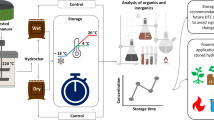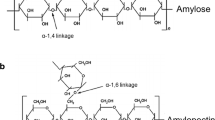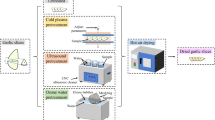Abstract
Osmotic dehydration effects on the kinetics and on some quality attributes of green banana slices (Musa cavendishii) at 25 °C with non-caloric solutes (glycerol, sorbitol, and a mixture of both) at concentrations varying from 40 to 60 g/100 g for up to 6 h were studied. The three-component diagram showed that the first pseudo-equilibrium was achieved, and the water pseudo-diffusion coefficient presented higher values with glycerol solutions. A modified Peleg’s model was applied to obtain the maximum water loss. Changes in green banana physical-chemical properties were observed: moisture content from 1.25 to 0.19 kg/kg dry basis, soluble solute content from 5.4 to 16.9 °Brix; total color-difference from 2.7 to 15.8; and the maximum biaxial extensional viscosity from 0.63 to 1.53 MPa s. Moreover, the obtained low chroma difference values suggest that the osmotically drying process may be a suitable technique to preserve the final color of green banana slices.






Similar content being viewed by others
References
Aminzadeh, R., Sargolzaei, J., & Abarzani, M. (2012). Preserving melons by osmotic dehydration in a ternary system followed by air-drying. Food and Bioprocess Technology, 5, 1305–1316.
ANVISA Agência Nacional de Vigilância Sanitária. (2010). Aditivos alimentares autorizados para uso segundo as Boas Práticas de Fabricação (BPF). RDC n° 45.
AOAC (2007). International official methods of analysis of AOAC. Gaithersburg: Association of Official Analytical Chemists.
ASTM—American Society for Testing and Materials (2014). ASTM Standard D2244-14. Standard practice for calculation of color tolerances and color differences from instrumentally measured color coordinates. West Conshohocken: ASTM International.
Atares, L., Sousa-Gallagher, M. J., & Oliveira, F. A. R. (2011). Process conditions effect on the quality of banana osmotically dehydrated. Journal of Food Engineering, 103, 401–408.
Azarpazhooh, E., & Ramaswamy, H. S. (2010). Evaluation of diffusion and Azuara models for mass transfer kinetics during microwave-osmotic dehydration of apples under continuous flow medium-spray conditions. Drying Technology, 28, 57–67.
Azoubel, P. M., & Murr, F. E. X. (2004). Mass transfer kinetics of osmotic dehydration of cherry tomato. Journal of Food Engineering, 61, 291–295.
Barat, J. M., Alvarruiz, A., Chiralt, A., & Fito, P. (1997). A mass transfer modelling in osmotic dehydration. In Proceedings of the Seventh International Congress on Engineering and Food. Brighton: ICEF.
Chenlo, F., Moreira, R., Fernandez-Herrero, C., & Vázquez, G. (2006). Mass transfer during osmotic dehydration of chestnut using sodium chloride solutions. Journal of Food Engineering, 73, 164–173.
Chiralt, A., Martínez-Navarrete, N., Martínez-Monzo, J., Talens, P., Moraga, G., Ayala, A., & Fito, P. (2001). Changes in mechanical properties throughout osmotic processes: cryoprotectant effect. Journal of Food Engineering, 49, 129–135.
FDA Food and Drug Administration. (2011). CFR - Code of Federal Regulations. Title 21-Food and Drugs. Chapter 1, Food and Drugs Administration. Subchapter B, Part 182—Substances generally recognized as safe. Section 182.1320. Glycerin.
Fernandes, F. A. N., Rodrigues, S., Gaspareto, O. C. P., & Oliveira, E. L. (2006). Optimization of osmotic dehydration of bananas followed by air-drying. Journal of Food Engineering, 77, 188–193.
Fernando, W. J. N., Low, H. C., & Ahmad, A. L. (2011). Dependence of the effective diffusion coefficient of moisture with thickness and temperature in convective drying of sliced materials. A study on slices of banana, cassava and pumpkin. Journal of Food Engineering, 102, 310–316.
Ferrari, C. C., Arballo, J. R., Mascheroni, R. H., & Hubinger, M. D. (2011). Modeling of mass transfer and texture evaluation during osmotic dehydration of melon under vacuum. International Journal of Food Science & Technology, 46, 436–443.
Fito, P., & Chiralt, A. (1996). Osmotic dehydration an approach to the modeling of solid food-liquid operations. In P. Fito & E. Ortega-Rodriguez (Eds.), Food Engineering 2000. New York: Springer.
Hofsetz, C. C. L., Hubinger, M. D., Mayor, L., & Sereno, A. M. (2007). Changes in the physical properties of bananas on applying HTST pulse during air-drying. Journal of Food Engineering, 83, 531–540.
Ispir, A., & Togrul, I. T. (2009). Osmotic dehydration of apricot: kinetics and the effect of process parameters. Chemical Engineering Research and Design, 87, 166–180.
Izidoro, D. R., Sierakowski, M. R., Haminiukc, C. W. I., Souza, C. F., & Scheer, A. P. (2011). Physical and chemical properties of ultrasonically, spray-dried green banana (Musa cavendish) starch. Journal of Food Engineering, 104, 639–648.
Langkilde, A. M., Cham, M., & Andersson, H. (2002). Effects of high-resistant-starch banana flour (RS2) on in vitro fermentation and the small-bowel excretion of energy nutrients, and sterols: an ileostomy study. American Journal of Clinical Nutrition, 75, 104–111.
Lazarides, H. N., Fito, P., Chiralt, A., Gekas, V., & Lenart, A. (1999). Advances in osmotic dehydration. In F. A. R. Oliveira & J. C. Oliveira (Eds.), Processing of foods: quality optimization and process assessments in conventional and emerging technologies. Boca Raton: CRC Press.
Mansueto, P., Seidita, A., D’Alcamo, A., & Carroccio, A. (2015). Role of FODMAPs in patients with irritable bowel syndrome. Nutrition in Clinical Practice, 30, 665–682.
Maskan, M. (2000). Microwave/air and microwave finish drying of banana. Journal of Food Engineering, 44, 71–78.
Mavroudis, N. E., Gidley, M. J., & Sjöholm, I. (2012). Osmotic processing: effects of osmotic medium composition on the kinetics and texture of apple tissue. Food Research International, 48, 839–847.
Mayor, L., Cunha, R. L., & Sereno, A. M. (2007a). Relation between mechanical properties and structural changes during osmotic dehydration of pumpkin. Food Research International, 40, 448–460.
Mayor, L., Moreira, R., Chenlo, F., & Sereno, A. M. (2007b). Osmotic dehydration kinetics of pumpkin fruits using ternary solutions of sodium chloride and sucrose. Drying Technology, 25, 1749–1758.
Mercali, G. D., Marczak, L. D. F., Tessaro, I. C., & Norena, C. P. Z. (2011). Osmotic dehydration of banana (Musa sapientum, shum.) in ternary aqueous solutions of sucrose and sodium chloride. Journal of Food Process Engineering, 35, 149–165.
Moreira, R., Chenlo, F., Torres, M. D., & Vázquez, G. (2007). Effect of stirring in the osmotic dehydration of chestnut using glycerol solutions. LWT - Food Science and Technology, 49, 1507–1514.
Moreira, R., Chenlo, F., Chaguri, L., & Mayor, L. (2010). Analysis of chestnut cellular tissue during osmotic dehydration, air drying, and rehydration processes. Drying Technology, 29, 10–18.
Moreno, J., Simpson, R., Sayas, M., Segura, I., Aldana, O., & Almonacid, S. (2011). Influence of ohmic heating and vacuum impregnation on the osmotic dehydration kinetics and microstructure of pears (cv. Packham’s triumph). Journal of Food Engineering, 104, 621–627.
Ochoa-Martínez, C. I., Ramaswamy, H. S., & Ayala-Aponte, A. A. (2009). Suitability of Crank’s solutions to Fick’s second law for water diffusivity calculation and moisture loss prediction in osmotic dehydration of fruits. Journal of Food Process Engineering, 32, 933–943.
Peleg, M. (1988). An empirical-model for the description of moisture sorption curves. Journal of Food Science, 53, 1216–1219.
Porciuncula, B. D. A., Zotarelli, M. F., Carciofi, B. A. M., & Laurindo, J. B. (2013). Determining the effective diffusion coefficient of water in banana (Prata variety) during osmotic dehydration and its use in predictive models. Journal of Food Engineering, 119, 490–496.
Raikham, C., Prachayawarakorn, S., Nathakarakule, A., & Soponronnarit, S. (2015). Influences of pretreatment and drying process including fluidized bed puffing on quality attributes and microstructural changes of banana slices. Drying Technology, 33, 915–925.
Rastogi, N. K., Raghavarao, K. S. M. S., & Niranjan, K. (1997). Mass transfer during osmotic dehydration of banana: Fickian diffusion in cylindrical configuration. Journal of Food Engineering, 31, 423–432.
Ruiz-López, I. I., Ruiz-Espinosa, H., Hernan-Lara, E., & Zárate-Castillo, G. (2011). Modeling of kinetics, equilibrium and distribution data of osmotically dehydrated carambola (Averrhoa carambola L.) in sugar solutions. Journal of Food Engineering, 104, 218–226.
Sacchetti, G., Gianotti, A., & Dalla Rosa, M. (2001). Sucrose-salt combined effects on mass transfer kinetics and product acceptability. Study on apple osmotic treatments. Journal of Food Engineering, 49, 163–173.
Silva, W. P., Silva, C. M. D. P. S., & Gomes, J. P. (2013). Drying description of cylindrical pieces of bananas in different temperatures using diffusion models. Journal of Food Engineering, 117, 417–424.
Simpson, R., Ramírez, C., Birchmeier, V., Almonacid, A., Moreno, J., Nunez, H., & Jaques, A. (2015). Diffusion mechanisms during the osmotic dehydration of Granny Smith apples subjected to a moderate electric field. Journal of Food Engineering, 166, 204–211.
Sirousazar, M., Mohammadi-Doust, A., & Achachlouei, B. F. (2009). Mathematical investigation of the effects of slicing on the osmotic dehydration of sphere and cylinder shaped fruits. Czech Journal of Food Sciences, 27, 95–101.
Souraki, B. A., Ghavami, M., & Tondro, H. (2014). Correction of moisture and sucrose effective diffusivities for shrinkage during osmotic dehydration of apple in sucrose solution. Food and Bioproducts Processing, 92, 1–8.
Steffe, J. F. (1992). Rheological methods in food process engineering (2nd ed.). East Lansing: Freeman Press.
Tabtiang, S., Prachayawarakon, S., & Soponronnarit, S. (2012). Effects of osmotic treatment and superheated steam puffing temperature on drying characteristics and texture properties of banana slices. Drying Technology, 30, 20–28.
Torreggiani, D. (1993). Osmotic dehydration in fruit and vegetable processing. Food Research International, 26, 59–68.
Torreggiani, D., Forni, E., Erba, M. A., & Longoni, F. (1995). Functional properties of pepper osmodehydrated in hydrolyzed cheese whey permeate with or without sorbitol. Food Research International, 28, 161–166.
Torres, J. D., Talens, P., Escriche, I., & Chiralt, A. (2006). Influence of process conditions on mechanical properties of osmotically dehydrated mango. Journal of Food Engineering, 74, 240–246.
Tribess, T. B., Hernández-Uribe, J. P., Méndez-Montealvo, M. G. C., Menezes, E. W., Bello-Pérez, L. A., & Tadini, C. C. (2009). Thermal properties and resistant starch content of green banana flour (Musa cavendishii) produced at different drying conditions. LWT - Food Science and Technology, 42, 1022–1025.
Zenebon, O., & Pascuet, N. S. (2005). Métodos físico-químicos para análises de alimentos do Instituto Adolfo Lutz (4th ed.). Brasilia: IAL.
Acknowledgments
The authors acknowledge São Paulo Research Foundation (FAPESP) under grants 2011/23599-0, 2011/22398-0, and 2012/13456-9.
Author information
Authors and Affiliations
Corresponding author
Rights and permissions
About this article
Cite this article
Chaguri, L., Sanchez, M.S., Flammia, V.P. et al. Green Banana (Musa cavendishii) Osmotic Dehydration by Non-Caloric Solutions: Modeling, Physical-Chemical Properties, Color, and Texture. Food Bioprocess Technol 10, 615–629 (2017). https://doi.org/10.1007/s11947-016-1839-2
Received:
Accepted:
Published:
Issue Date:
DOI: https://doi.org/10.1007/s11947-016-1839-2




